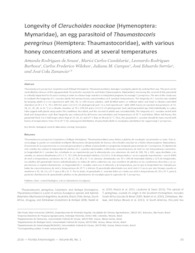Longevity of Cleruchoides noackae (Hymenoptera: Mymaridae), an egg parasitoid of Thaumastocoris peregrinus (Hemiptera: Thaumastocoridae), with various honey concentrations and at several temperatures.
Longevity of Cleruchoides noackae (Hymenoptera: Mymaridae), an egg parasitoid of Thaumastocoris peregrinus (Hemiptera: Thaumastocoridae), with various honey concentrations and at several temperatures.
Autoria: SOUZA, A. R. de; CANDELARIA, M. C.; BARBOSA, L. R.; WILCKEN, C. F.; CAMPOS, J. M.; SERRÃO, J. E.; ZANUNCIO, J. C.
Resumo: Thaumastocoris peregrinus Carpintero and Dellapé (Hemiptera: Thaumastocoridae), damages eucalyptus plants by sucking their sap. This pest can be controlled by releases of the egg parasitoid Cleruchoides noackae Lin and Huber (Hymenoptera: Mymaridae). Increasing the survival of this parasitoid is critically important for its mass rearing in order to release large numbers in integrated programs to manage T. peregrinus. The aim of this study was to evaluate the longevity of C. noackae adults fed various honey concentrations at 6 constant temperatures. The longevity of C. noackae was studied by keeping adults in a 1st experiment with 100, 50, or 10% honey solution, with distilled water, or without water and food in climate-controlled chambers at 25 ± 2 °C, 70 ± 10% RH, and a 12:12 h L:D photoperiod and?in a 2nd experiment?with 100% honey at constant temperatures of 15, 18, 21, 25, 28, or 31 °C in a climatic chamber at 70 ± 10% RH and a 12:12 h L:D photoperiod. Each adult parasitoid was held individually in a glass tube capped with plastic wrap under the conditions described, and the survival of adults was recorded daily. The longevity of C. noackae varied with food and temperature such that longevity was enhanced by all honey concentrations and temperatures of 25 °C and below. When fed honey, this parasitoid lived 2 to 3 fold longer when kept at 15, 18, 21, and 25 °C than at 28 and 31 °C. Thus, the parasitoid C. noackae should be mass reared with honey at temperatures from 15 to 25 °C for subsequent distribution of parasitoid adults in eucalyptus plantations for suppressing T. peregrinus.
Ano de publicação: 2016
Tipo de publicação: Artigo de periódico
Unidade: Embrapa Florestas
Palavras-chave: Biological control, Controle biológico, Eucalyptus, Laboratory rearing, Praga de planta, Thaumastocoris peregrinus
Observações
1 - Por padrão são exibidas publicações dos últimos 20 anos. Para encontrar publicações mais antigas, configure o filtro ano de publicação, colocando o ano a partir do qual você deseja encontrar publicações. O filtro está na coluna da esquerda na busca acima.
2 - Para ler algumas publicações da Embrapa (apenas as que estão em formato ePub), é necessário ter, no celular ou computador, um desses softwares gratuitos. Sistemas Android: Google Play Livros; IOS: iBooks; Windows e Linux: software Calibre.
Acesse outras publicações
Acesse a Base de Dados da Pesquisa Agropecuária (BDPA) para consultar o acervo completo das bibliotecas da Embrapa.

